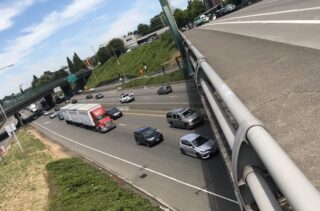
(Photo: Jonathan Maus/BikePortland)
It’s one thing for critiques of a project to swirl around transportation and advocacy circles; it’s another thing when a Pulitzer Prize-winning reporter hops onto the story.
That’s what happened today with the Willamette Week’s publication of an article titled Questions About the Footprint of the I-5 Rose Quarter Project Intensify. The news that ODOT is being intentionally dishonest about the true width of their I-5 expansion plans through the central city is not new. What’s important about Willamette Week reporter Nigel Jaquiss doing a story on it is that it gets the idea more firmly on the radar of influential local electeds and makes them comment about it on the record.
And Jaquiss has also furthered the story in a significant way: By highlighting new documents from the nonprofit No More Freeways that show the potential width of the freeway is even wider than anyone previously expected. Here’s an excerpt from his piece (emphasis mine):
Through public records requests, the group found two separate documents—one in a consultant’s report and another in a design drawing—that show the project’s right of way when it passes under the Broadway/Weidler interchange could be as wide as 160 feet but certainly no less than 126 feet.
More Freeways says the crucial point is that ODOT’s design calls for a footprint that is significantly wider than the current freeway at the Broadway/Weidler interchange, which the group pegs at 82 feet.
That opens the possibility for more lanes, traffic and emissions.
Advertisement
No More Freeways’ skepticism about the freeway width dates back to 2019. On March 12th 2019 BikePortland pointed out that ODOT’s marketing of this project is false because it hides the true width of the freeway footprint. On March 13th, City Observatory founder and economist Joe Cortright scrutinized the project further in an articled titled, The Hidden Rose Quarter Mega Freeway.
ODOT has denied that their project would increase driving capacity or that it should even be considered an expansion. In that March 2019 BikePortland article, ODOT spokesman Don Hamilton said, “It’s imprecise to say the Rose Quarter Plan will build more freeway lanes… Saying it builds more freeway lanes leaves the impression that there will be a large scale expansion of the freeway.”
“In reality,” Cortright countered in his article, “ODOT is engineering a right-of-way that can easily hold an 8 lane freeway — effectively doubling the size of the current Interstate 5.”
In today’s Willamette Week story, ODOT still denies the reality of the expansion saying, “Those shoulders are just extra space.”
But thanks to Jaquiss’ digging, the issue has finally opened more eyes. And important ones at that. Metro Council President Lynn Peterson apparently didn’t know about the true freeway width until Jaquiss spoke to her for the story. “That was 24 feet wider than I had envisioned. That raises several questions,” she told him.
If past is prologue, ODOT will simply answer those questions and move on. Whether Peterson moves on and continues to support the project — and whether yet another crack in the foundation of this project does anything to stop it — remains to be seen.
— Jonathan Maus: (503) 706-8804, @jonathan_maus on Twitter and jonathan@bikeportland.org
— Get our headlines delivered to your inbox.
— Support this independent community media outlet with a one-time contribution or monthly subscription.



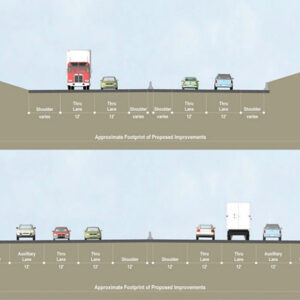
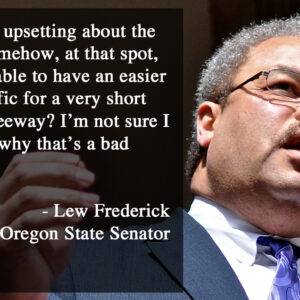
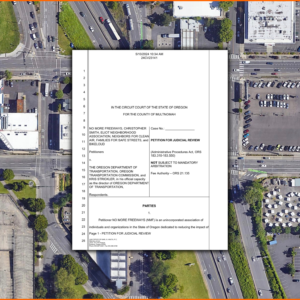
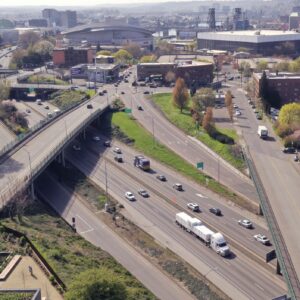
Thanks for reading.
BikePortland has served this community with independent community journalism since 2005. We rely on subscriptions from readers like you to survive. Your financial support is vital in keeping this valuable resource alive and well.
Please subscribe today to strengthen and expand our work.
But with the inability to expand to 8-lanes north or south of this point, there’s clearly no nefarious plan to hide future lanes.
I wonder if the extra space is for toll booths, for congestion pricing?
Doubtful. You don’t need that much extra space the entire length of the corridor if you are adding toll booths and/or overhead toll beacons in only a spot or two.
Some friends of mine think the concept of ” the deep state” is a myth. Clearly they have not paid attention to ODOT.
Historically, the phrase “deep state” has been used to describe situations like that in Egypt, where the military has a direct ownership stake in (by some estimates) almost half of the national economy. How does that description apply here? Or are you applying the definition contrived recently by conservative U.S. media, which is “government doing something I personally disagree with”?
Bikeninja is making a subtly snarky comment about the considerable “quiet” power of ODOT.
ODOT on I-5 = “Just extra space”
PBOT on Hawthorne = “Just a maintenance project”
Yes. However, the extra space on the north side of BH in that section gives a partial psychological feeling of protection. There is a thirty foot drop to Fanno Creek in part of that section.
Excellent work Aaron Brown et al. Keep it up. My hope is that this might force ODOT to an EIS. An EIS may lead ODOT to reflect reality at least in part in their evaluation: that adding lanes will indeed induce demand, increase emissions, may increase crashes, and VMT.
all credit to Joe Cortright and to our stellar FOIA team, including Iain, Alan and Dr. Goddard.
Right of Way is the land owned by ODOT, not (necessarily) the pavement. Slopes and roadsides are ROW . I’m not saying ODOT is being fully transparent, But this article gives the impression that Right of Way equals ares under pavement. Countering agency deception with agenda spun narratives is another form of deception.
While it’s true that right-of-way doesn’t necessarily mean the paved width, Jaquiss is clearly referring to the paved width. Maybe he’s technically incorrect in his language, but that doesn’t mean that advocates are being deceptive.
I admit I have no background knowledge about these kinds of projects, but how can something as important as how wide the freeway will be still be uncertain or still so vague? This project has been in design and studies for years but they are still uncertain how much land they will have to “buy” (eminent domain) and how much dirt they will have to dig up and move. This is obviously my ignorance talking, but I would imagine the first step is deciding how much space you will need/have. Then design how best to use it.
If they are still arguing over how much space they will need/have then what have they been spending so much money to “study”?
The project is staying entirely within the public right-of-way. They’re not using any eminent domain to buy property.
Great research, way to scoop The O.
Forward thinking infrastructure designers always try to build some flexibility into their designs vs always reconstructing, especially where future bottlenecks like bridges are…yes, it could be more MV capacity or as others have pointed out ‘tolling’ facilities…or perhaps room for regional protected micro mobility / bike lanes (Bike Super Highways) + regional rapid transit (BRT LRT). [I vote for a Bike Super Highway but I doubt it.]
[PS. For those valuing this type of research please consider supporting WW through a subscription etc.]
Urban freeways should be di-commissioned and replaced with affordable housing and new retail and commercial destinations. In Germany the Autobahns circle cities; our I-205 should be designated I-5, and the current I-5 removed, starting with this segment.
We shouldn’t be expanding I-5 through the Rose Quarter. I’ll say it again: we should be redesignating it as the last (or first) mile of I-84, ripping out the rest of what’s called I-5 through the Eastside as far as (and including) the Marquam Bridge, and renaming I-405 to I-5.
I agree, GlowBoy. I-5 should be ripped out throughout NoPo, the I-5 bridge made into a local bridge, and I-5 should take over Hwy 30 and cross the Columbia on a very tall bridge near St Helens (look at a map to see how this all makes sense).
Now that’s an interesting proposal, though vastly bigger in scope than what I’ve been advocating. By the way, there is already a very tall bridge over the Columbia at Longview (though the traffic impact to local streets in Kelso/Longview would be enormous).
Interesting proposal Fred, but I think baby steps might prove easier to evaluate over time. I agree that ODOT should prioritize building a bridge across the Willamette North of the St. John’s (which would then allow the St. John’s to become a local only bridge with a cycletrack). This bridge would allow freight to access the industrial area in N Portland, but more importantly, bypass I5 for much of its length.
The idea of having alternate routes makes the system more robust given any breakdowns. And expanding Hwy 30 would require ODOT to provide separated bike infra (unless they avoid it through loopholes).
Thanks for the coverage, Jonathan!
If you don’t mind the plug – No More Freeways just got an anonymous donor promising to match every dollar up to $2000. We’ve got a busy, litigious couple months ahead, and we’re so close to hitting our fundraising goal that’ll allow us to run the full gamut of what we have planned in the next few months. Every dollar goes towards our legal efforts and towards our PR – we’re an all volunteer effort.
Whether you can donate $2000, $200, or $20, every dollar helps – and we will mail you a button and a thank you card as appreciation:
http://www.nomorefreewayspdx.com/donate
Um, save the Flint Ave. overpass, anyone???
If the RQ project were to be put on a ballot, I think many here would be surprised by the outcome. Among my non-activist friends in Portland that I’ve asked, almost every single one has said that they support the project. I offer no opinion myself, but we really have to be careful to not create an echo chamber where we only hear our voices and not engage the general public.
The thing is – the only way ODOT can get support for the project is to lie about it. All their polling shows a majority of support – but only after you tell them it improves air pollution, reduces carbon emissions, or improves traffic. We know that all of these claims are true, and what we need is people who read bikeportland to tell their friends and legislators that they want to see this project cancelled.
They support freeway expansions, but they don’t want to pay for them. They also won’t really benefit from the expansion, because congestion will be just as bad in a few years.
I mostly agree with your last sentence, but from my observations the general public doesn’t.
Does the “general public” feel good about using almost one billion dollars to add one “auxiliary” lane in each direction? Next time you talk to your friends, ask them what else they’d do with a billion dollars.
They honestly do. The Portland metro is backsliding, I wouldn’t be surprised to organized opposition to urban growth boundaries in the near future.
The reality is that PBOT and TriMet have largely failed in their missions. The general public, if they have an opinion at all, thinks PBOT is fighting a war on cars and it’s all these damn cyclist taking up all the space and money and making it harder to drive. PBOTs inaction has made it harder and more dangerous to get around by any mode of transportation. We blame motorist, motorist blame us.
TriMet on the other hand focuses its energies onto mega projects and street redesign while their bus service is poor. Pretty much anyone who can afford to not use it does so.
The public perceives single-occupant vehicles to be the mode of transit that “just works” and it’s hard to blame them when TriMet and PBOT have made the city impossible to get around any other way. Most people wouldn’t pause for a second at $1 billion for the RQ is they (mistakenly) thought that it would make it faster to drive around the city.
I agree. And will add that I believe a longer-term backlash to perceived “progressiveness” is underway in the Portland metro area and that when this is paired with the demographics of people moving to Portland (wealthier and older) we are in for years of retrenchment. I still have some faint hope that the center-left and left will abandon pyrrhic infighting to form coalitions that oppose Fordism but it’s a faint hope.
Focusing on the width of the right-of-way is really a bit misdirected.
The right-of-way is devoted to lots of different uses. First, it’s not all pavement. Second, not all of the pavement is destined for travel lanes (shoulders for breakdowns or emergency vehicle access to crash sites). Substantial parts of the right-of-way are used for slopes (notice the difference in elevation between I-5 and the adjoining streets?), some for stormwater management, signs, street lights, etc. It’s often possible to reduce the right-of-way width by replacing slopes with much more expensive retaining walls; stormwater management can be accommodated by putting runnoff in pipes, transporting it elsewhere and treating it there. Both add significantly to the cost.
The width analogy in your home is whether to use 2 x 6 stud walls with cheap fiberglass insulation or 2 x 4 walls with much more expensive foam insulation. Both can be used to achieve the desired r value. Is reducing the width worth the extra expense? Same thing applies to highway design and construction.
I think you need to look at the actual diagrams in this case:
https://cityobservatory.org/revealed-odots-secret-plans-for-a-10-lane-rose-quarter-freeway/
It is clear from the cross-sections they uncovered that ODOT is essentially establishing a buffer zone that could be paved to the outside of the “3-lane plus shoulders” interstate here. Honestly, it’s a smart move. It would give them the flexibility to make 4 or even 5 through lanes in each direction at some point in the future. But they need to be honest with the public about their intentions here.
Yep, it’s a good catch. 12 foot shoulders are the standard these days to provide space for vehicles to pull over in case of a crash or other issue, but historically these shoulders have often been converted to general purpose lanes over time. So it’s a legitimate concern that they are just trying to “future-proof” and allow future capacity increases. I personally don’t see the need for breakdown shoulders on both sides. It seems like just having one shoulder on the right side is all that’s needed. 12 feet on both sides is over-kill.
Odot largely exists to do one thing…build. Take that away…and what do you have? Every reason to lie.